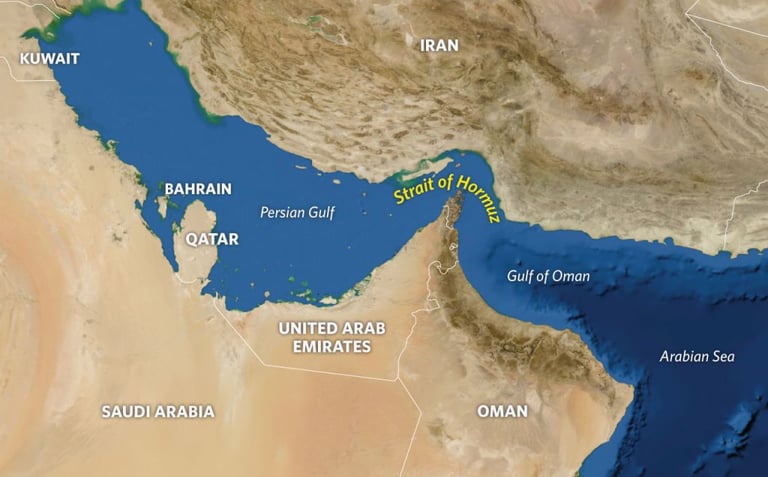The Strait of Hormuz: Strategic Importance and Economic Impacts on Global Supply Chains
Roopesh


The Strait of Hormuz, a narrow waterway connecting the Persian Gulf to the Gulf of Oman, is a critical chokepoint for global energy trade, handling approximately 20-30% of the world’s crude oil and 25-35% of liquefied natural gas (LNG) trade.
Its strategic importance stems from its role as the primary export route for oil and gas from key producers like Saudi Arabia, Iran, Iraq, Kuwait, Qatar, and the UAE.
Historical Context
The Strait of Hormuz has been a vital trade route for centuries, linking Persian Gulf resources to global markets. Its modern significance emerged with the 20th-century oil boom, making it a geopolitical flashpoint.
Key events include:
Iran-Iraq War (1980-1988): The “Tanker War” saw attacks on oil tankers, disrupting global oil supplies and raising prices.
2011-2012 Tensions: Iran threatened to close the Strait amid U.S. sanctions, causing oil price spikes.
2019 Incidents: Attacks on tankers and the seizure of the Stena Impero heightened global concerns.
2024-2025: Iran’s seizure of the MSC Aries (2024) and threats to close the Strait in June 2025, amid Israel-Iran tensions, underscored ongoing risks.
These events highlight the Strait’s vulnerability to disruptions, which can destabilize global energy markets.
Importance to Global Supply Chains
Oil Transit: The EIA reports that 21 million barrels per day (b/d) of crude oil and petroleum products transited the Strait in 2022, representing ~20% of global oil consumption. Saudi Arabia (7 million b/d), Iraq (3.5 million b/d), and the UAE (2.5 million b/d) are major exporters.
LNG Transit: Qatar, the world’s largest LNG exporter, shipped ~25% of global LNG through the Strait in 2023, per IEA data.
Economic Implications: A closure could push oil prices to $100-$350 per barrel, increasing inflation, shipping costs, and production costs across industries like transportation, manufacturing, and petrochemicals.
Alternative Routes: Limited alternatives, such as Saudi Arabia’s East-West Pipeline (5 million b/d) and the UAE’s Fujairah Pipeline (1.5 million b/d), cannot offset a full closure, per EIA analysis.
Impacts on Top 10 Economies
The top 10 economies (based on 2025 nominal GDP estimates) are differentially affected by Strait disruptions due to their energy import dependencies and domestic production capacities.
Negatively Affected Economies
China:
Impact: Severe. As the world’s largest oil importer, China sourced $128 billion in Gulf crude in 2021. A disruption would spike energy costs, disrupt manufacturing, and fuel inflation, threatening its export-driven economy.
Data: 50% of China’s oil imports transit the Strait, per IEA.
Japan:
Impact: Severe. Japan imports 67% of its crude from Gulf countries via the Strait (EIA, 2022). Higher energy costs would impact its automotive and electronics sectors.
India:
Impact: Significant. India’s crude oil import dependency is 87.7% (PPAC, 2023-2024). Approximately 66% of its oil imports transit the Strait, down from 84% in 2019 due to increased Russian imports (40% in 2023). Disruptions would raise fuel prices and inflation, affecting agriculture and manufacturing.
South Korea:
Impact: Significant. Like Japan, South Korea relies on Gulf oil (67% of Strait flows to Asia, EIA 2022), impacting its tech and shipping industries.
Germany, United Kingdom, France, Italy:
Impact: Moderate to significant. These European economies face higher energy costs and inflation from disruptions, affecting manufacturing and consumer prices. The UK and France may incur additional security costs due to naval operations in the region.
Positively Affected or Less Impacted Economies
United States:
Impact: Positive. The U.S. imports only 0.7 million b/d from the Gulf (11% of imports, EIA 2022). Domestic shale production and exports could benefit from higher global prices, boosting revenue. However, inflation risks remain.
Canada:
Impact: Positive. As a net oil exporter, Canada benefits from price surges, with minimal reliance on Gulf oil.
Saudi Arabia, Iraq, Kuwait, Qatar, UAE: These nations face severe revenue losses from disruptions, as 80-90% of their oil and LNG exports rely on the Strait.
Iran: Despite its threats, Iran’s own oil exports (1.5 million b/d) would be crippled by a closure, per EIA.
Analysis
Energy Security Risks: Asian economies (China, Japan, India, South Korea) face the greatest risks due to high import dependency. Europe faces secondary impacts via global price increases. The U.S. and Canada are insulated by domestic production.
Geopolitical Dynamics: Iran’s leverage over the Strait creates risks, but its own economic dependence on oil exports limits the likelihood of a sustained closure. U.S. naval presence and China’s diplomatic efforts (e.g., Saudi-Iran deal, 2023) aim to maintain stability.
Conclusion
The Strait of Hormuz remains a linchpin of global energy trade, with disruptions posing severe risks to energy-importing economies like China, Japan, India, and South Korea, while benefiting exporters like the U.S. and Canada. Gulf nations face significant revenue losses from closures. Strategic diversification, reserve stockpiling, and diplomatic efforts are critical to mitigate risks. Stakeholders should prioritize energy security and regional stability to safeguard global supply chains.
References
U.S. Energy Information Administration (EIA). (2022). "World Oil Transit Chokepoints." https://www.eia.gov
International Energy Agency (IEA). (2023). "Oil Market Report."
Petroleum Planning and Analysis Cell (PPAC), India. (2024). "Petroleum Statistics." https://ppac.gov.in
Reuters. (2023). "India’s Russian Oil Imports Surge." https://www.reuters.com
The Hindu. (2024). "India’s Energy Security and the Strait of Hormuz."
Maritime Study Forum. (2019). "Strait of Hormuz: Strategic Importance."